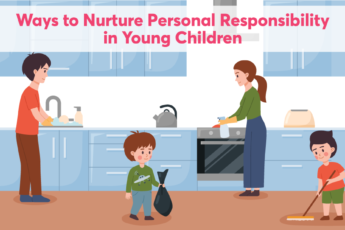Why We Need Phonics In Early Childhood Education
Well before infants can understand any words, for example, they find speech interesting to listen to, and prefer it to other kinds of sounds (Shultz & Vouloumanos, 2010).
Phonics, at its very core, is the method applied to teach people how to read and write an alphabetic language using sounds.
Phonics has been around for a long time, and is one of the most recommended methods of teaching in schools, especially in Early Childhood Care and Education (ECCE). In fact, American President Benjamin Franklin even attempted to create his own alphabet to replace the existing one.
This article answers the most common questions about phonics and related terms, its use in Indian schools, and how it can be used in the classroom.
What does the term ‘phonics’ actually mean?
Phonics helps teachers and educators develop reading skills in children by linking sounds in a language to the letters and words that represent them. Phonics instruction has a profound impact on young learners’ brains and studies have even shown its effectiveness over other teaching methods.
What are some common terms related to phonics?
Phonological Awareness: This is the awareness of the sound structure of any language. Children can recognise and work with any sound of the spoken language once they develop phonological awareness. For e.g., they can pick out words that rhyme, break up a sentence into words, and more.
Phonemic Awareness: This is the ability to notice and work with individual sounds (or phonemes) in spoken language. For e.g., blending sounds to make words, breaking up words into individual sounds, and more.
Why is phonics so important in early childhood?
Sounding out words becomes easier: Phonics breaks down words into components, helping children ‘read’. Over time, they can even recognise patterns in words and automatically learn to read them correctly.
Links sounds and letters: As the phonics method uses sounds to link to respective letters or letter groups, children know exactly which sound should be produced for each letter or letter group, making the reading process simpler.
Long words become easier to read: Unlike when children learn a language via complete words, phonics breaks down longer words into individual sounds. Young children eventually learn to break down (and read) any long word into sounds even if they do not understand its meaning.
Children gain secondary skills: While phonics primarily aims to develop the reading skill, children also simultaneously learn to think logically (as they read words they don’t understand), and pick up writing skills (during spelling-related phonics exercises).
Why must we ‘teach’ sounds?
Even as children automatically pick up sounds since birth, they are not completely equipped to process the information on their own. For example, children would not automatically know that ‘MAT’ and ‘MAP’ begin with the same sound, or that ‘PAN’ and ‘DAD’ have the same sound of ‘a’. This suggests that children need to know how sounds map to a written system, and for this, they need explicit phonics instruction.
Why not simply teach children to read? Won’t that help them map sounds to written words?
Being read to is another crucial aspect of foundational learning, but it cannot replace phonics instruction. A study by Evans & Saint-Aubin in 2005 showed that as children were being read to from a storybook, they spent much longer looking at pictures than reading the words or text. It is not realistic to expect young children to learn much about mapping sounds and written words simply from being read to.
How does phonics work in Indian languages?
Most Indian languages are ‘pure phonic languages’, i.e., the word sounds exactly like it is written. Plus, every sound has a specific written representation which does not change. For example, Hindi and Marathi use a Devanagari script, and the sound of each alphabet in this language is distinctly different. अ remains the same pronunciation, whether the word is अनार or अक्षर.
While only a small percentage of Indian schools focus on phonics and related activities at present, this method of instruction has been highly recommended for ECCE in the recently released NIPUN document and the National Education Policy (or NEP 2020), for all languages.
Can phonics be included as a small part of each lesson?
Sounds are already a part of every lesson, and there are quick tricks educators and teachers can use to leverage this for a revision lesson. For example, after a story session, children can count the syllables in each word, they can rhyme with numbers (one-sun), and even simply sound out letters they have learnt previously.
Can parents also help with phonics instruction?
The home environment is crucial to develop holistic foundational skills, say experts. The role of parents in fostering their children’s development is twofold: they introduce children to sound, and play a crucial part in reinforcing teachers’ instructions. Parents can be given a list of words and stories introduced in school, which they can repeat with the children during daily chores and activities. Parents can also ask questions about further letter sound knowledge, like ‘What is the beginning sound of this word?’ or ‘What is the last letter in this word, and what sound does it make?’ Parents unfamiliar with the language can listen to songs and rhymes in the language of instruction with their children, and encourage their little ones to sing along.
What sort of activities can help children develop phonemic awareness?
Simple letter identification activities can be turned into phonic games, by asking children to also sound out the letter. In the same way, sorting activities can be grouped as per rhymes, syllables, beginning sounds, and more. You can even group children in pairs for a ‘partner reading’ exercise, where one child reads a small text and the other closely copies the first. They can then switch roles, helping each other when they stumble.

Learn how to turn even the simplest of items into a learning resource for phonics and language development in next week’s Square Panda Thursday’s webinar. Join the live session on July 29, at 5 pm: https://squarepanda.app.link/e/2907b
Phonics teaches children to be fluent in a language while reading. To be more efficient, this instruction needs to work hand-in-hand with vocabulary instruction and other types of learning for a well-rounded development. From an educational perspective, being able to predict the pronunciation of words using letter-sound knowledge is better than rote learning the pronunciation of all words.




Leave a Comment